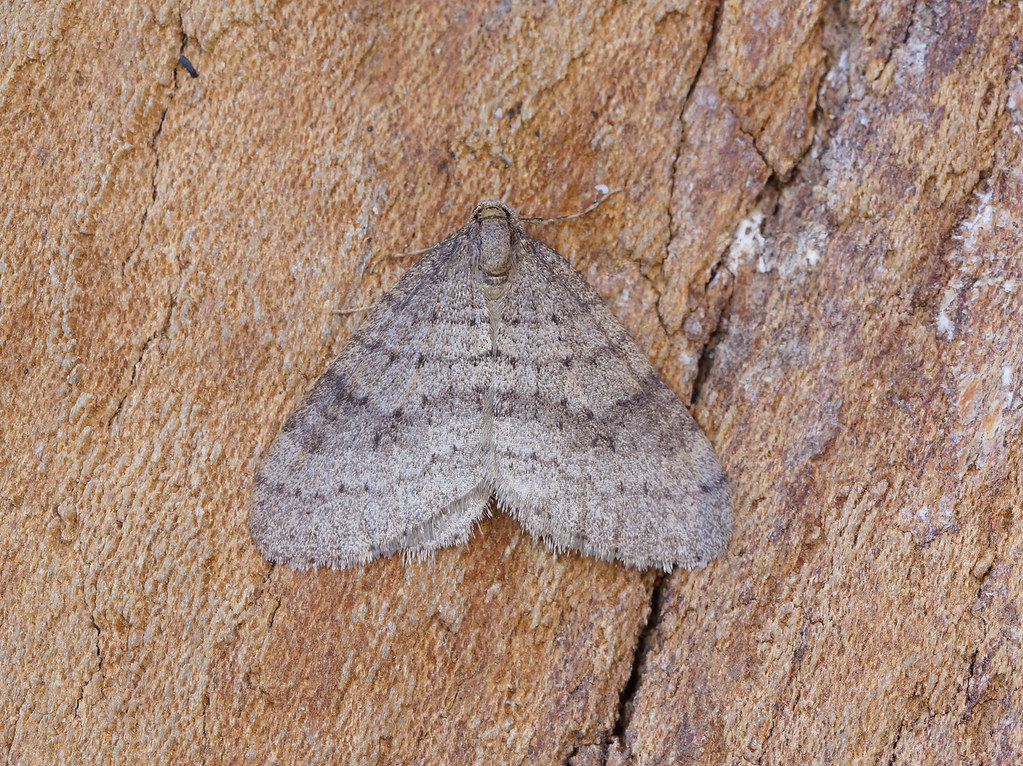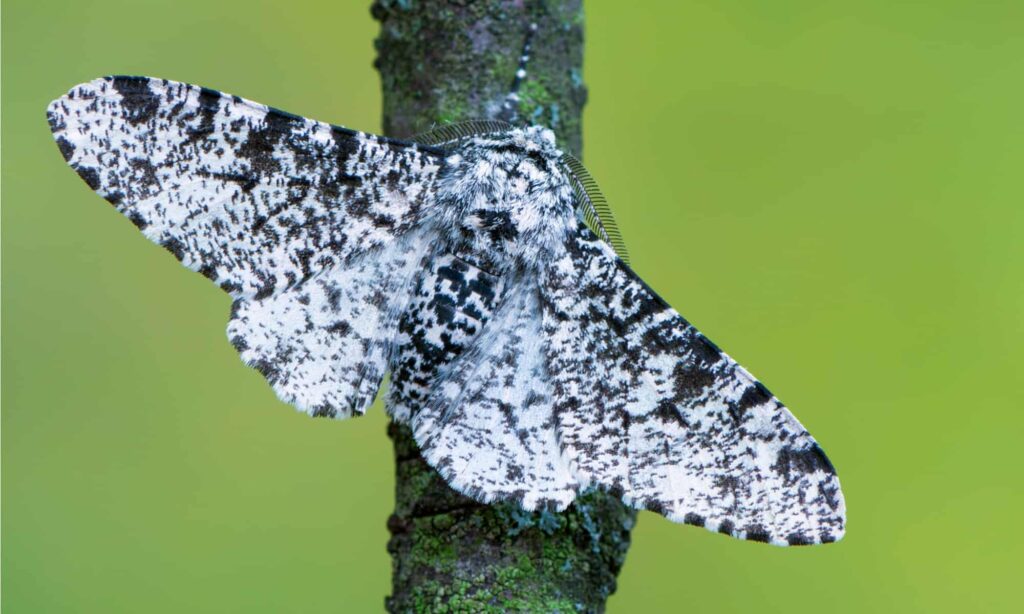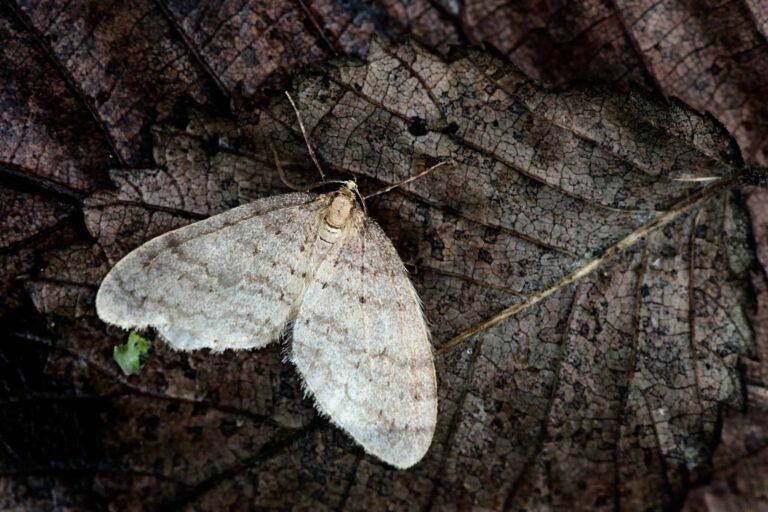Peppered moths, like many insects, spend the winter in a state of dormancy and diapause. During this time, they seek shelter, reduce their activity and metabolism, blend in with their surroundings for camouflage, and do not feed.
Moreover, they have adaptations to survive cold temperatures, and reproduction is paused until spring. When temperatures rise, they become active again and prepare for the breeding season. Their specific winter behaviors can vary depending on their location and environmental conditions.
How do peppered moths shelter in winter?
Seeking sheltered locations is a crucial aspect of how peppered moths spend the winter.
These shelters not only offer protection from predators and harsh weather conditions but also aid in temperature regulation, predator avoidance, and energy conservation.
Seeking Sheltered Locations:
Peppered moths are adept at locating natural hiding spots in their environment. These spots often include crevices in tree bark, gaps in rocks, or other concealed areas that provide physical protection from predators and the elements.
Many peppered moths exhibit a preference for resting on tree trunks, particularly those that match their mottled coloration. This preference enhances their camouflage and reduces their vulnerability to predation.
When selecting shelter, peppered moths tend to position themselves vertically on surfaces such as tree trunks. This behavior minimizes their visibility to potential predators and optimizes their concealment.
Protection from Cold and Inclement Weather

Peppered moths select sheltered locations not only to evade predators but also to regulate their body temperature. These shelters act as thermal buffers, shielding moths from extreme temperature fluctuations during the winter months.
Furthermore, sheltered spots also shield moths from the effects of winter winds and precipitation. These locations provide a degree of insulation, reducing the risk of desiccation due to cold winds or water exposure.
Some sheltered locations create microclimates that are slightly warmer and more stable than the surrounding environment. This can be critical for moths to conserve energy and endure prolonged periods of cold weather.
In addition to temperature and weather protection, sheltered spots help peppered moths avoid visual detection by predators. Remaining hidden during the winter months is crucial for their survival.
By finding sheltered spots, peppered moths can reduce their energy expenditure. They can conserve energy by minimizing movement and maintaining a state of dormancy, which is vital when food sources are scarce in winter.
How does diapause help peppered moths conserve energy?
Peppered moths undergo significant metabolic changes during the winter. They slow down their metabolic rates, which includes reduced respiration and digestion. This metabolic slowdown allows them to conserve energy and cope with limited food resources during this season.
Furthermore, the reduction in metabolism is closely tied to temperature sensitivity. As the environment cools during winter, biochemical reactions within the moths’ bodies become less efficient. Slowing their metabolism helps them cope with these temperature-related challenges.
State of Dormancy to Conserve Energy
Diapause is a form of dormancy that many insects, including peppered moths, enter during unfavorable conditions like winter. In response to environmental cues such as decreasing day length and lower temperatures, moths initiate diapause to conserve energy and increase their chances of survival.
During diapause, peppered moths become less active and cease most of their normal behaviors. This includes feeding, mating, and reproduction. By conserving energy and minimizing movement, they can survive on stored reserves for an extended period.
In addition, diapause significantly increases the longevity of peppered moths. While their average lifespan might be relatively short, entering a state of dormancy allows them to survive through the harsh winter conditions, ensuring they are alive and ready to reproduce when spring arrives.
Camouflage to Blend in with Surroundings
Peppered moths have evolved remarkable camouflage that matches the patterns and colors of tree bark, their primary resting surfaces. This adaptation serves to hide them from visual predators, especially birds.
Furthermore, the moths’ mottled coloration, which includes light and dark patches, helps them blend seamlessly with the texture and coloration of tree trunks. This makes it challenging for predators to spot them when they are at rest.
In addition to their physical appearance, peppered moths exhibit behavioral camouflage. They tend to position themselves in a way that aligns with the bark’s features, further enhancing their concealment.
Moreover, camouflage is a key survival strategy during the winter months when peppered moths are vulnerable to predation. Being inconspicuous helps them avoid becoming a meal for birds and other visual hunters.
How do peppered moths adjust their winter feeding?
During winter, the scarcity of nectar sources and a metabolic slowdown lead to reduced or halted feeding in adult moths.
Seasonal Feeding Patterns
Peppered moths undergo complete metamorphosis, consisting of egg, larval (caterpillar), pupal, and adult stages. Most of their feeding occurs during the larval stage. Larvae primarily consume the leaves of their host plants, which are typically deciduous trees like birch and oak.
Adult peppered moths, which emerge from pupation in the summer, also engage in feeding. They primarily feed on nectar from flowers using their proboscis, a long, straw-like mouthpart. Nectar provides them with the energy and nutrients required for activities such as mating and egg-laying.
Peppered moths time their feeding activities in alignment with the availability of their food sources. Larvae feed during the warmer months when host tree leaves are abundant, typically from spring to early summer. Adult moths feed on nectar from flowering plants during the summer and early fall when these food sources are readily available.
Reduced or Halted Feeding During Winter
One of the main reasons adult peppered moths reduce or halt their feeding during winter is the scarcity of nectar-producing flowers. As temperatures drop, many flowering plants cease to bloom, making nectar unavailable.
Moreover, adult moths enter a state of reduced metabolic activity during the winter, similar to the diapause observed in other stages of their life cycle. This metabolic slowdown decreases their energy requirements, further reducing the need for feeding.
By minimizing feeding or ceasing it altogether, adult moths conserve their energy reserves. This energy conservation is crucial because it helps them endure the extended period of dormancy and inactivity associated with winter.
During the winter months, the primary focus of peppered moths shifts from reproduction to survival. Their energy resources are redirected towards maintaining basic physiological functions and ensuring they can withstand the cold temperatures and predator threats.
In addition, reproductive activities, including mating and egg-laying, are typically postponed until the return of more favorable conditions in the spring. By delaying reproduction, peppered moths ensure that their offspring will have a better chance of survival in the warmer months.
How do peppered moths survive freezing temperatures?
Peppered moths have evolved various adaptations to survive freezing temperatures, including antifreeze proteins and the production of glycerol.
Adaptations to Withstand Freezing Temperatures
Cold-Hardiness: Peppered moths are adapted to withstand cold temperatures. They have physiological and behavioral mechanisms that help them survive freezing conditions.
Supercooling: Supercooling is a process that allows moths to remain in a liquid state below the freezing point without forming ice crystals. This is achieved by controlling the nucleation and growth of ice crystals within their bodies.
Antifreeze Proteins: Some peppered moths produce antifreeze proteins that inhibit ice crystal formation within their bodily fluids.
Moreover, these proteins lower the freezing point of their body fluids, preventing them from freezing even in subzero temperatures.
Hibernation Sites: Selecting well-insulated hibernation sites, such as tree crevices, provides protection from extreme cold and wind.
In addition, these sites create microclimates that are less prone to temperature fluctuations.
Production of Glycerol as a Natural Antifreeze
Another crucial adaptation is the production of glycerol, a natural antifreeze compound, by some peppered moth species. Glycerol acts as a cryoprotectant by lowering the freezing point of their bodily fluids.
Glycerol accumulates in the moths’ body fluids, such as hemolymph (insect “blood”), and effectively depresses the freezing point, preventing the formation of ice crystals. This adaptation helps them survive subfreezing temperatures.
Furthermore, the production of glycerol is often linked to the seasonal changes in temperature. Moths may produce more glycerol as temperatures drop in preparation for winter diapause.
Glycerol is stored in various tissues and organs, allowing moths to maintain its presence in their bodies throughout the winter months. This ensures their survival even during the coldest periods.
When and how do peppered moths reproduce during winter?

Their timing of reproduction, diapause in eggs or pupae, and resumption of reproductive activities in spring are strategies that ensure the survival and success of their offspring in changing seasonal conditions.
Timing of Mating and Egg-Laying
Peppered moths typically engage in mating and egg-laying activities in the late summer or early fall, before the onset of winter. This timing ensures that their offspring will hatch in spring when food sources become more abundant.
By reproducing before winter, moths give their larvae a better chance of survival, as they will have access to fresh leaves from host plants when they emerge in the spring.
Diapause in Eggs or Pupae
Some populations of peppered moths enter diapause as eggs or pupae. Diapause is induced by environmental cues such as decreasing day length and lower temperatures, signaling the approach of winter.
During diapause, development is temporarily halted. Eggs or pupae remain in a state of suspended animation until conditions become more favorable in the spring.
FAQ’s
How did the peppered moths survive?
Peppered moths survived through a combination of adaptive strategies such as camouflage, seasonal timing of reproduction, diapause, and physiological adaptations to cold temperatures.
What are the 4 stages of the peppered moth life cycle?
The four stages of the peppered moth life cycle are egg, larva (caterpillar), pupa (chrysalis), and adult.
Why did dark peppered moths have a survival advantage?
Dark peppered moths had a survival advantage during the industrial revolution in England because their coloration helped them blend into the soot-covered trees, making them less visible to predators.
Why were the peppered moths able to survive changes in England’s environment?
Peppered moths were able to survive changes in England’s environment due to their ability to adapt to shifting ecological conditions, including changes in tree bark color and increased predation.
How did peppered moths become dark?
Peppered moths became dark through a natural selection process called industrial melanism. Dark-colored moths had a genetic advantage in polluted environments, and their frequency increased over time.
What does the peppered moth eat?
Peppered moth larvae (caterpillars) primarily feed on the leaves of host trees, such as birch and oak. Adult peppered moths feed on nectar from flowers using their proboscis.
Why are they called peppered?
Peppered moths are called “peppered” due to the small, scattered black specks on their wings, which resemble the appearance of grains of pepper against a lighter background. This speckled pattern is characteristic of their wings.
Final Thought
In conclusion, peppered moths employ a range of adaptive strategies to endure the challenges posed by winter. They seek shelter in concealed locations, reduce their metabolic activity through dormancy, and employ camouflage for survival.
Limited feeding and a focus on energy conservation help them endure food scarcity during the colder months. To withstand freezing temperatures, they utilize natural antifreeze compounds like glycerol and develop mechanisms for supercooling.
Additionally, the timing of their reproduction, diapause in various life stages, and the resumption of reproductive activities in spring are vital to their long-term survival and reproductive success.
Moreover, these collective adaptations and behaviors highlight the remarkable resilience of peppered moths in adapting to the changing seasons and maintaining their population in the face of environmental challenges.

